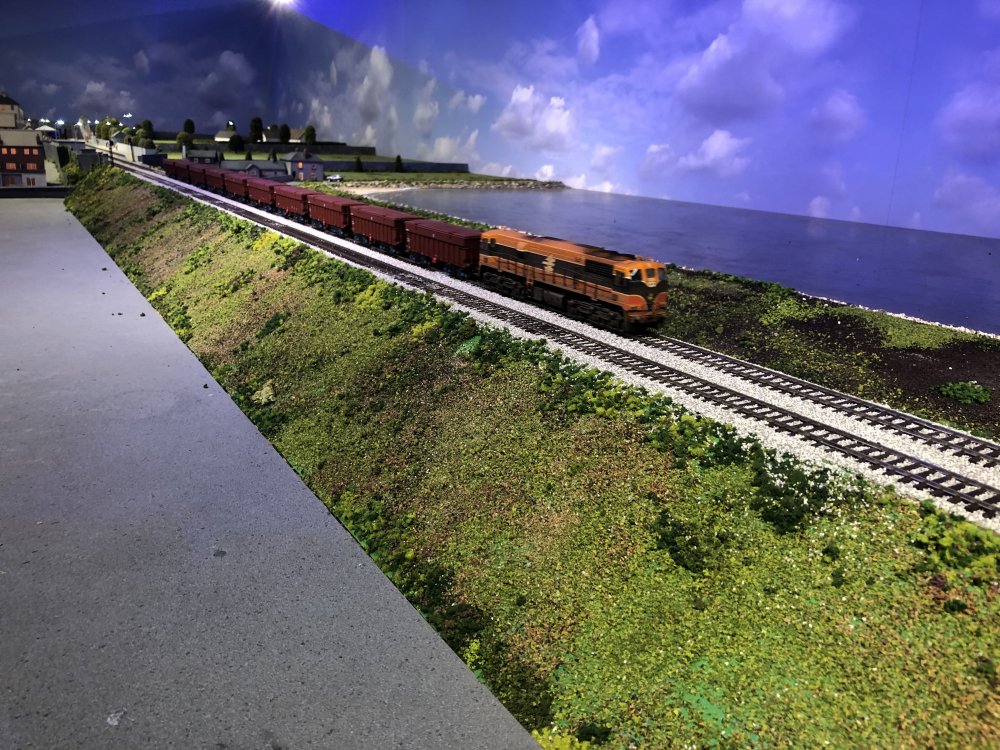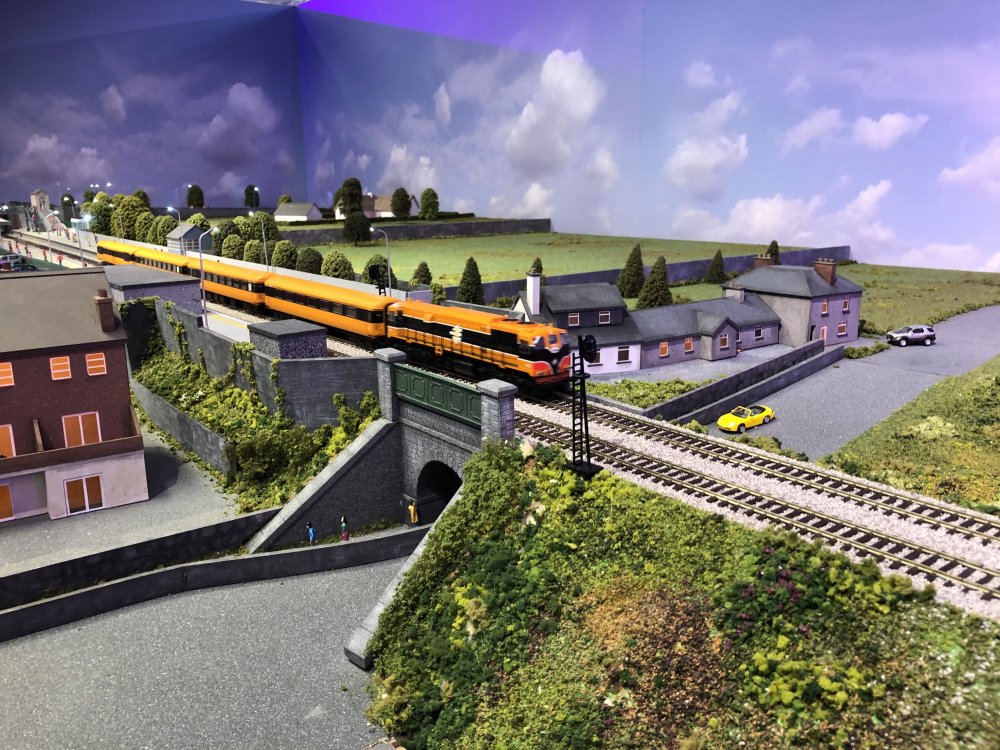-
Posts
15,831 -
Joined
-
Last visited
-
Days Won
393
Content Type
Profiles
Forums
Events
Gallery
Blogs
Store
Community Map
Everything posted by jhb171achill
-
This was a one-off reprint for a special event, though it did briefly operate in traffic in it. Thus, it could be seen as an actual, if extremely short-lived "livery"; but they never carried it before. GSWR green of the 1870-1895 period was an extremely dark green, as seen on one of Fry's models or No. 90 at Downpatrick. They painted engines lined black from 1895 to about 1915-18, then grey onwards and to working steam's oblivion. A few familiar faces in that video, most now departed......
-
It was actually clockwork motors and rubber bands that NIR put in them...........
-
Today, the above three sets were in action, plus a 2-car 2700. They'll be rotated, as will locomotives from time to time. There are five sets of 0 gauge stuff made up for eventual use on the overhead track. These are from the "Castle" models - i.e. the stuff built in the 1990s for the old Malahide Castle layout. From memory (it's weeks since i put them in boxes), there is a J15 plus a couple of six-wheelers, a few wagons and a van, for a 1950s set. For the 1960s, a 141 and coaches in black'n'tan. For the 1970s an 071 and Mk 2 set. For the 1980s another 071 with a mix of bubbles, Guinness four wheelers and 4 wheel container flats. There's a "C" which can also do the 1950s or 1960s set also.
-
Saw the Tara going through today, and the Enterprise back in 1987.... But there was an issue with the Cork service today. Due to the less frequent service as a result of Covid-19, crews are less familiar with the route knowledge aspect of it. The crew of the 11:00 to Cork got lost today, and are shown here entering Malahide, where the driver had to stop to ask for directions. IMG_2658.MOV IMG_2658.MOV
-
I’d be interested to see a three-wheeler....! Fry’s model is a 1st class coach, indeed. It must be remembered, of course, that some six-wheelers - usually firsts, mail vans or full passenger brake vans, were often on main line trains mixed in with bogies ancient and modern, right up to the early 1960s....
-
A maroon “C” class! Now that’s a very nice “Might-have-been”!
-
I’ve no idea, Edo. There’s no evidence of anything continental as such in early railway station design here - though many early British railways also had low platforms. Probably just an “early railway” thing.
-
Postscript: now that I think of it, several Cobh line ones remained low into the 80s, with some on the Youghal line low until closure. Adore was low too, as were some others on the North Kerry, and the (only two!) on the Waterford & Tramore were too. A number of West Cork platforms were lower than normal but not quite as low as the GSWR.
-
I travelled very short distances in several guards vans. Steel ones, in all reality, were an absolute endurance test, even for a diehard railway enthusiast! What a LONG distance must have been like - say Limerick - Sligo on a bad winters day......gawd only knows!
-
Skanger in doorway "Got a few pence, Bud?" Full black bin liner sitting on pavement beside litter bin!!
-
It's not Ballyhaise..... could well be Maguiresbridge, though. The picture is taken from a conventional wooden-bodied coach, though, not a railcar set - which means that the net could possibly be wider. AEC / BUT's wouldn't have been on that route in that year, though - they rarely ventured beyond Clones until very late on.
-
Depends. The DSER, MGWR and GNR always had full height platforms, but the GSWR had low ones, like in mainland Europe. Quite a few were still like that into the mid 1970s, when many smaller ones closed (Knocklong, Goold’s Cross, Killonan, etc.). Mallow, however, still had low platforms until at least 1980 and possibly a few years after that. I think it was the last.
-
I agree, Robert, but I’d say it would be a brave man who would suggest it to the RPSI guys!
-
Indeed; a light grey livery on a working locomotive was just as nonsensically impractical as the silver livery on earlier loco classes. It actually gets to the stage where a pristine one on a layout barely looks realistic! Now - for the very serious bravery awards - WHO will be the first to weather a 121 (OR a silver A!) to a state of apparently shocking, filthy cosmetic neglect!
-
I will prostrate myself accordingly and say six Hail IRMs.....
-
I would say that in this day and age, something familiar to younger enthusiasts would be better, though it wouldn't be my thing. The obvious would be an ICR set, or an 071 & half a dozen Taras or ballast wagons; or three or four container flats with containers and a 201.
-
Imagine if the smouldering embers had gone off that night when nobody was about, and blown the thing apart! I'd love to be a fly on the wall when the teachers were trying to work out what little so-and-so in Fourth Year had broken into the school after dark................
-
That firm, Gleeson & O'Dea, named on the stove above was the family business of the renowned railway photographer, James P O'Dea, whose excellent collection resides in the National Library. https://commons.wikimedia.org/wiki/File:Gleeson_O'Dea_%26_Co._Ltd._No._21-22,_Christchurch_Place,_Dublin_City,_Co._Dublin._(27648328816).jpg
-
And another story, from when I worked on the Festiniog Railway as a summer job when I was 17 (so, ten years ago). I was in the PW Dept., (following Senior's footsteps!) and one of the supervisors was a retired British Army veteran, who was as mad as a bag of frogs. He told the story that one time he was out on army "exercises" in the Scottish mountains in winter, and they had to "hole up" overnight when a vicious snowstorm came out of nowhere. They walked along a railway line and found a PW hut with one of these stoves in it. They got the fire lit, but our hero decided to play a trick on his colleagues. As they huddled round the fire inside it, he went outside and dropped several bangers down the chimney. B A N G ! ! ! ! ! ! ! ! ! ! The cast-iron stove split into three pieces, dousing three trainee Paras with hot bits of burning wood and setting fire to the sleeper floor. The three inside said some rude words to him as a result.........
-
I recall a story told to me over thirty years ago by a friend in the business of apprehending people "doing stuff"; as a trainee apprehender, he was part of a crew called to the North Wall goods yard where they caught red-handed some young gentlemen helping themselves to colour TVs in a container on a railway wagon! The gentlemen concerned ended up being invited by the State to spend a while with free bed and board.....
-
A CIE van but a GSWR stove; on the face of it a mismatch, but as can be seen the railway companies often used outside contractors to buy stoves, just like with signalling components. Therefore, especially in 00 scale, there's no reason to think that a CIE one was substantially - if at all - different. Certainly, any I recall were like that. This level of detail makes this van an absolute must! Maybe increase my order to four or five! For those interested, or as nerd-like obsessed as me, like much in Cultra the exterior livery is wrong in many ways! Do you still pay a decent rate for informers?
-
There’s a CIE van at Whitehead, but I’m not sure if it still has a stove..... anyone? Plus the NCC one at Downpatrick?
-
Wouldn't like to be wherever that box was!
-
Don't you love the spotless coupling! I think that's the plough van that was used in the H blocks in 1980........................ or is that too controversial?
.png.c363cdf5c3fb7955cd92a55eb6dbbae0.png)






